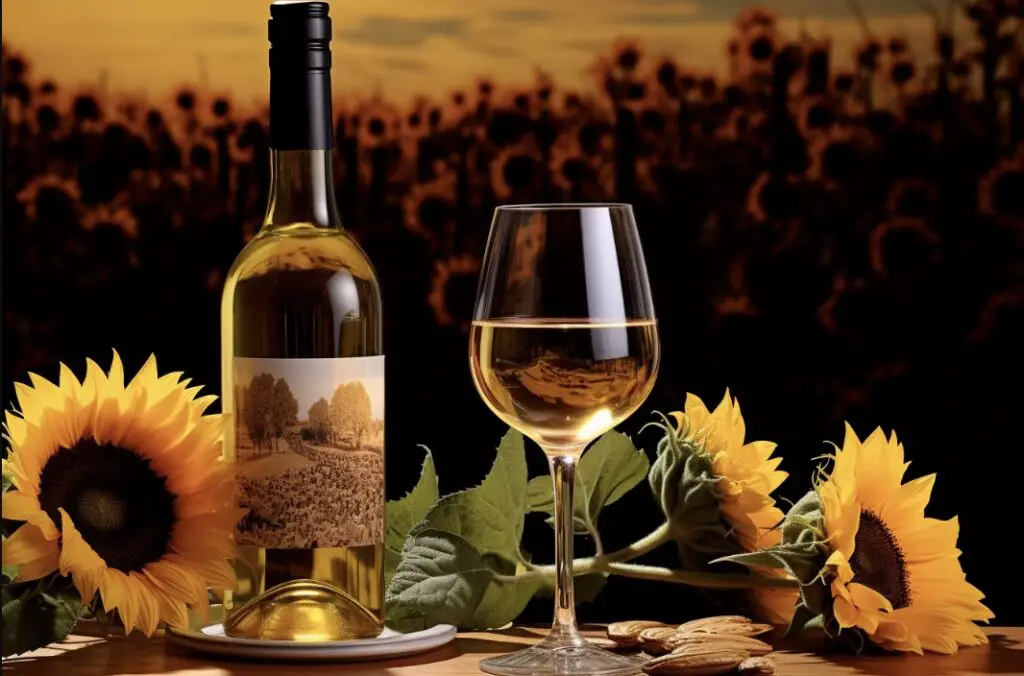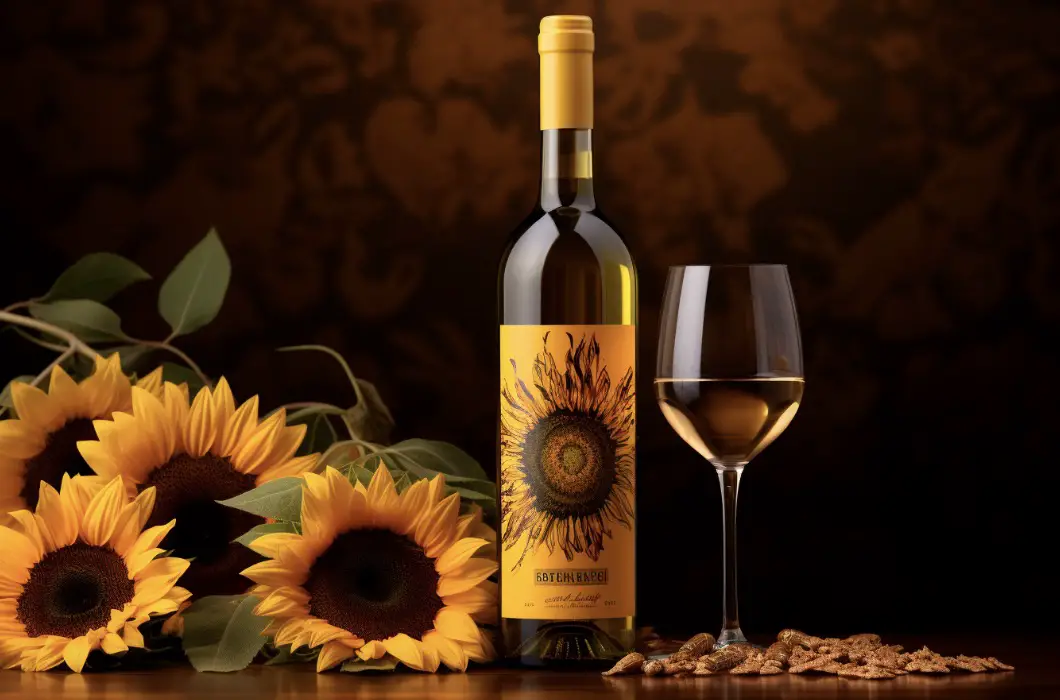As an experienced brewer, I’ve spent countless hours experimenting with different ingredients and techniques in my quest to create the perfect homemade wine.
One of my most successful experiments has been sunflower wine. Yes, you read it right! The majestic sunflower, aside from being a beautiful sight in your garden, can also be used to make an unexpectedly delicious wine.
Is it possible to make wine from sunflowers?
Undeniably, yes! Sunflowers are not only beautiful to look at, but they also yield a surprisingly crisp and refreshing wine, with a unique floral taste. In this blog post, I will share my personal sunflower wine recipe with you, step by step.
Make a simple wine base at home
As sunflowers don’t have much juice, we need to add it to something else before fermenting. Before adding the sunflowers, we need to make a simple wine base first.
To make a simple wine at home, you will need the following ingredients and equipment:
Ingredients:
- Fresh grapes or grape juice. Green grapes are best.
- Yeast
- Sugar (optional, for adjusting sweetness)
Equipment:
- Fermentation vessel (glass or food-grade plastic)
- Airlock
- Straining cloth or fine mesh bag
- Sanitizing solution
- Wine bottles or containers for storage
Here’s a step-by-step process:
1. Sanitize all equipment thoroughly to ensure a clean environment for fermentation.
2. If using fresh grapes, remove them from the stems and crush them to extract the juice. If using grape juice, skip this step.
3. Place the crushed grapes or grape juice into the fermentation vessel, leaving some space at the top for foaming during fermentation.
4. Add yeast to the vessel following the instructions on the package. Yeast helps convert the sugars into alcohol.
5. If desired, add sugar to adjust the sweetness level of the wine. This step is optional and depends on personal preference.
6. Cover the fermentation vessel with an airlock to allow carbon dioxide to escape while preventing oxygen from entering. This helps maintain a healthy fermentation process.
7. Store the vessel in a cool, dark place with a consistent temperature between 60-70°F (15-21°C). Fermentation typically takes 1-2 weeks, but it can vary.
8. After fermentation is complete, strain the wine using a cloth or fine mesh bag to remove any solids or sediments.
9. Taste the wine and adjust sweetness or acidity if necessary by adding sugar or lemon juice in small increments.
10. Bottle the wine in clean, sanitized containers, leaving some headspace to allow for further aging and expansion.
11. Store the bottles in a cool, dark place for a few weeks or longer to allow the flavors to develop.
12. Enjoy your homemade wine responsibly! Note that the quality and taste may vary depending on the ingredients, fermentation conditions, and aging period.
Remember to research and follow local regulations regarding home winemaking, as they may vary.
Choosing Your Sunflowers
The first step in making sunflower wine is, of course, choosing your sunflowers. It’s important to pick sunflowers that are fully mature and in full bloom. The flowers should be bright yellow, with no signs of wilting or disease.
If you’re growing your own sunflowers, this means you’ll need to wait until late summer or early fall when the sunflowers are at their peak. If you’re buying sunflowers, look for fresh, vibrant flowers from a reputable source.
Remember, the quality of your ingredients will directly affect the quality of your wine, so don’t skimp on this step!
Preparing Your Sunflowers
Once you’ve chosen your sunflowers, the next step is to prepare them for the wine-making process. This involves removing the petals from the flower heads and discarding the rest of the plant.

You’ll want to rinse the petals thoroughly to remove any dirt or insects, then pat them dry. It’s crucial to make sure the petals are completely dry before you move on to the next step, as any excess moisture can interfere with the fermentation process.
The Fermentation Process
This is where the magic happens! The fermentation process is what turns your sunflower petals into delicious, alcoholic wine.
To start, you’ll need to combine your sunflower petals with your wine base at the early stages of fermentation.
The mixture needs to be kept in a cool, dark place and stirred daily for about a week. After a week, you can strain out the petals and transfer the liquid (rack) to a new fermentation vessel to continue the process.
Aging Your Sunflower Wine
After the fermentation process is complete, it’s time to age your sunflower wine. The aging process allows the flavors to develop and the wine to mellow, resulting in a smoother, more enjoyable drink.
Sunflower wine should be aged for at least six months, although it can be aged for up to a year for a richer flavor. Keep the wine in a cool, dark place and avoid disturbing it during the aging process.
Bottling Your Sunflower Wine
Once your sunflower wine has aged sufficiently, it’s time to bottle it. Sterilize your bottles before use to prevent any bacteria from spoiling your wine.
When bottling your wine, fill each bottle to about 3/4 full, leaving enough space for the wine to expand without causing the bottle to break.
Enjoying Your Sunflower Wine
Now, the moment you’ve been waiting for: it’s time to enjoy your sunflower wine! This wine pairs well with a variety of foods, but it’s especially delightful with light, summery dishes like salads and seafood.
Sunflower wine has a unique, floral flavor that’s unlike any other wine you’ve tried. It’s a refreshing change from traditional grape wines, and it’s sure to be a hit at your next dinner party!
Conclusion
Creating your own sunflower wine is a rewarding process that allows you to enjoy a unique, tasty beverage made with your own hands. Not only does it offer a refreshing change from traditional grape wines, but it also gives you a chance to make the most of the beautiful sunflowers you’ve grown in your garden or sourced from a local supplier.
Here are 10 interesting facts about sunflower wine:
1. Sunflower wine has a unique floral flavor.
2. You can make sunflower wine using the petals of the flower.
3. Sunflower wine requires a fermentation process to produce alcohol.
4. The wine should be aged for at least six months for the best flavor.
5. Sunflowers should be fully mature and in full bloom before they’re used for wine.
6. The petals should be thoroughly rinsed and dried before use.
7. A specific wine yeast is required for the fermentation process.
8. Sunflower wine pairs well with light, summery dishes.
9. Sterilizing your bottles is an essential step in the bottling process.
10. Making your own sunflower wine is a rewarding and enjoyable process.
FAQs
How much fruit do I need for 1 gallon of wine?
The amount of fruit needed to make 1 gallon of wine varies depending on the type of fruit and the desired intensity of flavor. As a general guideline, you will typically need around 3-4 pounds (1.4-1.8 kg) of fruit per gallon of wine. However, it’s important to note that this can vary significantly based on the specific fruit, its sugar content, and personal preference.
Can you use too much fruit in wine making?
Yes, using too much fruit in winemaking can have negative effects on the final product. Excessive amounts of fruit can overpower the wine, leading to imbalanced flavors and aromas. It can also result in a higher sugar content, potentially causing fermentation issues and producing a wine that is overly sweet. Achieving the right balance of fruit is crucial for creating a well-rounded and harmonious wine.




